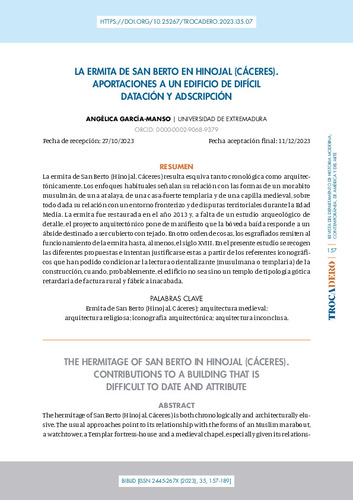La ermita de San Berto en Hinojal (Cáceres). Aportaciones a un edificio de difícil datación y adscripción

Identificadores
URI: http://hdl.handle.net/10498/32238
DOI: 10.25267/Trocadero.2023.i35.07
ISSN: 2445-267X
Files
Statistics
Metrics and citations
Share
Metadata
Show full item recordAuthor/s
García-Manso, AngélicaDate
2023Source
Trocadero. Revista del Departamento de Historia Moderna, Contemporánea, de América y del Arte, 35, 2023, pp. 157-189Abstract
La ermita de San Berto (Hinojal, Cáceres) resulta esquiva tanto cronológica como arquitec-
tónicamente. Los enfoques habituales señalan su relación con las formas de un morabito
musulmán, de una atalaya, de una casa-fuerte templaria y de una capilla medieval, sobre
todo dada su relación con un entorno fronterizo y de disputas territoriales durante la Edad
Media. La ermita fue restaurada en el año 2013 y, a falta de un estudio arqueológico de
detalle, el proyecto arquitectónico pone de manifiesto que la bóveda baída responde a un
ábside destinado a ser cubierto con tejado. En otro orden de cosas, los esgrafiados remiten al
funcionamiento de la ermita hasta, al menos, el siglo XVIII. En el presente estudio se recogen
las diferentes propuestas e intentan justificarse estas a partir de los referentes iconográfi-
cos que han podido condicionar la lectura orientalizante (musulmana o templaria) de la
construcción, cuando, probablemente, el edificio no sea sino un templo de tipología gótica
retardaria de factura rural y fábrica inacabada. The hermitage of San Berto (Hinojal, Cáceres) is both chronologically and architecturally elu-
sive. The usual approaches point to its relationship with the forms of an Muslim marabout,
a watchtower, a Templar fortress-house and a medieval chapel, especially given its relationship with a border environment and territorial disputes during the Middle Ages. The chapel
was restored in 2013 and, in the absence of a detailed archaeological study, the architectural
project shows that the vaulted ceiling was an apse intended to be covered with a roof. On
another note, the sgraffitoes refer to the functioning of the hermitage until at least the 18th
century. In this study, the different proposals are brought together and an attempt is made
to justify them on the basis of the iconographic references that may have conditioned the
Orientalist (Muslim or Templar) interpretation of the construction, when the building is
probably nothing more than an rural Gothic-retardant church of unfinished construction.





